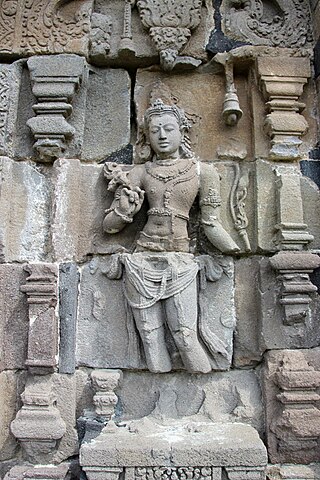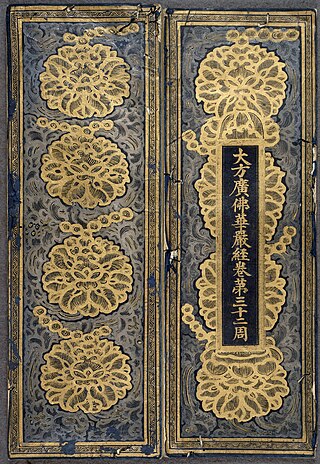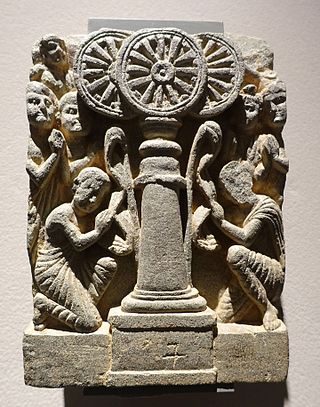
In Buddhism, a bodhisattva ( BOH-dee-SUT-və; or bodhisatva is a person who is on the path towards bodhi or Buddhahood.

Amitābha is the principal Buddha of Pure Land Buddhism. He is also known as Amitāyus, which is understood to be his enjoyment body (Saṃbhogakāya). In Vajrayana Buddhism, Amitābha is known for his longevity, discernment, pure perception, and the purification of aggregates with deep awareness of the emptiness of all phenomena. The name Amitābha means "Infinite Light", and the name Amitāyus means "Infinite Life".

In Buddhism, Buddha, "awakened one", is a title for those who are spiritually awake or enlightened, and have thus attained the supreme religious goal of Buddhism, variously described as nirvana, awakening (bodhi) and liberation (vimutti). A Buddha is also someone who has fully understood the Dharma, the true nature of things or the universal law. Buddhahood is the condition and state of a buddha. This highest spiritual state of being is also termed sammā-sambodhi. This state is interpreted in many different ways in the various schools of Buddhism.

Pure Land Buddhism or Pure Land School is a broad branch of Mahayana Buddhism focused on achieving rebirth in a Pure Land. It is one of the most widely practiced traditions of Buddhism in East Asia.

Chinese Buddhism or Han Buddhism is a Chinese form of Mahāyāna Buddhism which draws on the Chinese Buddhist Canon as well as numerous Chinese traditions. Chinese Buddhism focuses on studying Mahayana sutras and Mahāyāna treatises and draws its main doctrines from these sources. Some of the most important scriptures in Chinese Buddhism include: Lotus Sutra, Flower Ornament Sutra, Vimalakirtī Sutra, Nirvana Sutra, and Amitābha Sutra. Chinese Buddhism is the largest institutionalized religion in Mainland China. Currently, there are an estimated 185 to 250 million Chinese Buddhists in the People's Republic of China. It is also a major religion in Taiwan, Singapore, and Malaysia, as well as among the Chinese Diaspora.

The Buddhāvataṃsaka-nāma-mahāvaipulya-sūtra is one of the most influential Mahāyāna sutras of East Asian Buddhism. It is often referred to in short as the Avataṃsaka Sūtra. In Classical Sanskrit, avataṃsaka means garland, wreath, or any circular ornament, such as an earring. Thus, the title may be rendered in English as A Garland of Buddhas, Buddha Ornaments, or Buddha’s Garland. In Buddhist Hybrid Sanskrit, the term avataṃsaka means “a great number,” “a multitude,” or “a collection.” This is matched by the Tibetan title of the sutra, which is A Multitude of Buddhas.

The Mahāyāna sūtras are a broad genre of Buddhist scripture (sūtra) that are accepted as canonical and as buddhavacana in Mahāyāna Buddhism. They are largely preserved in Sanskrit manuscripts, the Pāli Canon, and translations in the Tibetan Buddhist canon and Chinese Buddhist canon. Several hundred Mahāyāna sūtras survive in Sanskrit, or in Chinese and Tibetan translations. They are also sometimes called Vaipulya ("extensive") sūtras by earlier sources. The Buddhist scholar Asaṅga classified the Mahāyāna sūtras as part of the Bodhisattva Piṭaka, a collection of texts meant for bodhisattvas.

Buddhist texts are religious texts that belong to, or are associated with, Buddhism and its traditions. There is no single textual collection for all of Buddhism. Instead, there are three main Buddhist Canons: the Pāli Canon of the Theravāda tradition, the Chinese Buddhist Canon used in East Asian Buddhist tradition, and the Tibetan Buddhist Canon used in Indo-Tibetan Buddhism.

Mañjuśrī is a bodhisattva who represents prajñā of the Buddhas in Mahāyāna Buddhism. His name means "Gentle Glory" in Sanskrit. Mañjuśrī is also known by the fuller name of Mañjuśrīkumārabhūta (मञ्जुश्रीकुमारभूत), literally "Mañjuśrī, Still a Youth" or, less literally, "Prince Mañjuśrī". Another name of Mañjuśrī is Mañjughoṣa.
In Mahayana Buddhism, bodhicitta,, is the mind (citta) that is aimed at awakening (bodhi), with wisdom and compassion for the benefit of all sentient beings. Bodhicitta is the defining quality of the Mahayana bodhisattva and the act of giving rise to bodhicitta (bodhicittotpāda) is what makes a bodhisattva a bodhisattva. The Daśabhūmika Sūtra explains that the arising of bodhicitta is the first step in the bodhisattva's career.

Buddhism includes a wide array of divine beings that are venerated in various ritual and popular contexts. Initially they included mainly Indian figures such as devas, asuras and yakshas, but later came to include other Asian spirits and local gods. They range from enlightened Buddhas to regional spirits adopted by Buddhists or practiced on the margins of the religion.

In Buddhism, refuge or taking refuge refers to a religious practice, which often includes a prayer or recitation performed at the beginning of the day or of a practice session. Since the period of Early Buddhism all Theravada and mainstream Mahayana schools only take refuge in the Three Jewels, which are the Buddha, the Dharma and the Sangha.

Samantabhadra is a great bodhisattva in Buddhism associated with practice and meditation. Together with Shakyamuni Buddha and the bodhisattva Mañjuśrī, he forms the Shakyamuni Triad in Mahayana Buddhism. He is the patron of the Lotus Sutra and, according to the Avatamsaka Sutra, made the ten great vows which are the basis of a bodhisattva. In Chinese Buddhism, Samantabhadra is known as Pǔxián and is associated with action, whereas Mañjuśrī is associated with prajñā. In Japan, this bodhisattva is known as Fugen, and is often venerated in Tendai and Shingon Buddhism.

Mahāsthāmaprāpta is a bodhisattva mahāsattva who represents the power of wisdom. His name literally means "arrival of the great strength".

The Bodhisattva vow is a vow taken by some Mahāyāna Buddhists to achieve full buddhahood for the sake of all sentient beings. One who has taken the vow is nominally known as a bodhisattva. This can be done by venerating all Buddhas and by cultivating supreme moral and spiritual perfection, to be placed in the service of others. In particular, bodhisattvas promise to practice the six perfections of giving, moral discipline, patience, effort, concentration and wisdom in order to fulfill their bodhicitta aim of attaining buddhahood for the sake of all beings.
The Innumerable Meanings Sutra also known as the Sutra of Infinite Meanings is a Mahayana buddhist text. According to tradition, it was translated from Sanskrit into Chinese by Dharmajātayaśas, an Indian monk, in 481, however Buswell, Dolce and Muller describe it as an apocryphal Chinese text. It is part of the Threefold Lotus Sutra, along with the Lotus Sutra and the Samantabhadra Meditation Sutra. As such, many Mahayana Buddhists consider it the prologue to the Lotus Sutra, and Chapter one of the Lotus Sutra states that the Buddha taught the Infinite Meanings just before expounding the Lotus Sutra.
Samantabhadri is a dakini and female Buddha from the Vajrayana Buddhist tradition. She is the consort and female counterpart of Samantabhadra, known amongst some Tibetan Buddhists as the 'Primordial Buddha'. Samantabhadri herself is known as the 'primordial Mother Buddha'. Samantabhadri is the dharmakaya dakini aspect of the Trikaya, or three bodies of a Buddha. As such, Samantabhadri represents the aspect of Buddhahood in whom delusion and conceptual thought have never arisen. As font or wellspring of the aspects of the divine feminine she may be understood as the 'Great Mother'. Seen differently, Samantabhadri is an aspect of Prajnaparamita.

The Samantabhadra Meditation Sūtra, also known as the Sūtra of Meditation on the Bodhisattva Universal Virtue, is a Mahayana Buddhist sutra teaching meditation and repentance practices.

Mahāyāna is a term for a broad group of Buddhist traditions, texts, philosophies, and practices developed in ancient India. It is considered one of the three main existing branches of Buddhism, the others being Theravāda and Vajrayāna. Mahāyāna accepts the main scriptures and teachings of early Buddhism but also recognizes various doctrines and texts that are not accepted by Theravada Buddhism as original. These include the Mahāyāna sūtras and their emphasis on the bodhisattva path and Prajñāpāramitā. Vajrayāna or Mantra traditions are a subset of Mahāyāna which makes use of numerous tantric methods Vajrayānists consider to help achieve Buddhahood.















